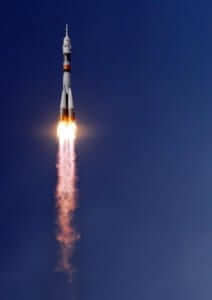
Commercial and military space exploitation never want for a motive. Like the bronze and silver lower classes of Plato’s Republic, most space exploitation thrives on common motives of profit and security. But human space exploration, like the gold class of Plato’s Republic, requires a higher impulse: the desire to know. align=”right” Part one of a two-part series.
The great problem of space exploration is the limits of chemical energy. Until this problem is solved—with a nuclear rocket or space elevator—the equation between the mass you want to lift and the fuel you need to lift it with will continue to expand geometrically.
To address this, for commercial and military space exploitation, engineering investment tends toward miniaturization. Research dollars are better spent reducing the size and weight of the payloads than on increasing size and power of rockets. Inconveniently, these rules do not apply to human space exploration. Human beings cannot be miniaturized, and human space exploration requires the development of larger and more spectacular rockets.
The two great savants of human spaceflight of the past are Sergei Korolev and Wernher von Braun. Sergei Korolev was a Soviet Russian engineer. Not merely a brilliant engineer, Korolev was a managerial and political genius. Korolev used this genius to steer the Soviet Union into leadership in human space exploration in spite of itself.
The first Soviet hydrogen bomb capable of delivery on an intercontinental ballistic missile weighed six tons. To meet the demands of hurling this mass to another continent, Korolev’s design bureau manufactured an over-built liquid oxygen and kerosene rocket. Delivered in 1957, the rocket consisted of a central core, powered by one main turbo pump and four main combustion chambers, and four strap-on boosters, each also powered by one main turbo pump and four chambers. Designated the R-7, the missile would launch from an above ground pad constructed in the open at Baikonur Cosmodrome, in Kazakhstan in a configuration still used today.

Almost certainly it was Korolev’s intention that the R-7 would be more than meets the eye. It had far more potential lifting capacity than the six tons required and would serve as an excellent base platform for human space exploration. The R-7—with several series of modifications and improvements none of which altered its basic design—launched Sputnik, the first dog in space, the first man in space, the first woman in space, the Soviet unmanned missions to Mars, Venus, and the moon, and ferried cosmonauts to low earth orbit (LEO) space stations Salyut and Mir. It remains in service today—with over 1,700 cumulative launches—as the unparalleled workhorse of LEO. Its direct descendant, Suyoz is the only remaining means of manned travel to the International Space Station.
German rocket pioneer Wernher von Braun likewise began dreaming about human space exploration. The development of rockets required enormous capital outlays and von Braun found his willing backer in Nazi Germany, which provided the enormous facility at Peenemunde for the development and production of the V-2 rocket.
At the end of the war, von Braun was captured by the Americans, and under Operation Paperclip von Braun, along with other lesser German engineers, was shipped to the Redstone Arsenal in Huntsville, Alabama to develop ballistic missiles. In 1958, after Sputnik flew on a modified R-7 rocket, the United States formed a dedicated civilian space exploration agency, NASA, to compete with Soviet space exploration.
Von Braun had promoted human space exploration in published writings starting in 1950 and was the logical candidate for director of NASA in 1960, a position he took on the condition that he be permitted to develop Saturn. When Kennedy endorsed the goal of placing a man on the moon within a decade, the president was merely parroting the ideas that von Braun’s remarkable managerial and political abilities had planted in his adopted country, giving birth to the program that would build the heavy-lift rocket, capable of placing 310,000 pounds into low-earth orbit, that would deliver six manned moon landings.
After the moon landings, the American public would lose interest in space exploration beyond LEO, and after three decades (from 1981-2011) the United States, mired in an unending series of insurgent wars, would abandon all serious will for human space exploration, retiring the inspired—but ultimately flawed—Space Shuttle without a replacement program, thus ceding a monopoly on manned space flight to Russia. Without a visionary who could manipulate the state to spend the enormous amounts of capital needed for human space exploration, U.S. space exploration simply died, as human space exploration gave way to the horribly confused priorities of identity politics under Barack Obama.
Photo credits: Oxford Science Archive/Print Collector/Getty Images (Top); Dmitry Kostyukov/AFP/Getty Images (Middle)

